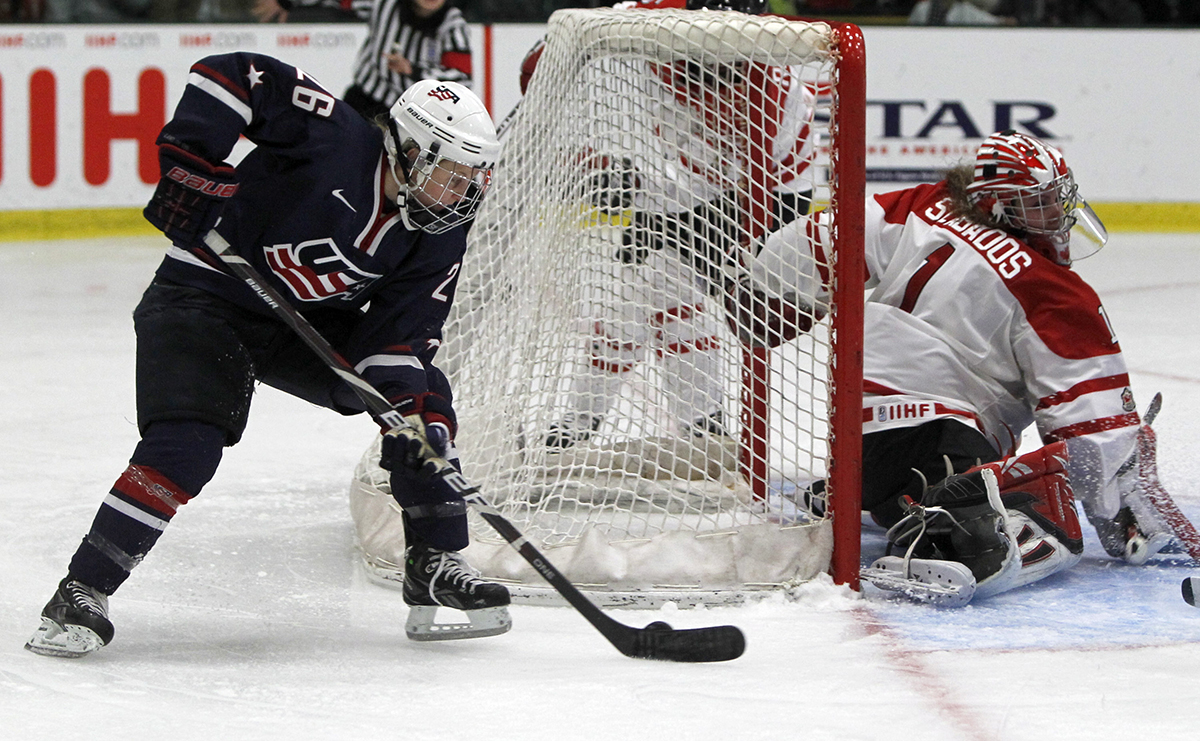The Golden Age of Professional Women’s Hockey

Boston Pride first-round pick Kendall Coyne at the 2012 World Women’s Ice Hockey Championships. (Photo via AP)
SUDDEN DEATH. Corinne Buie of the Boston Blades collects the puck at the blue line and—as two Montreal Stars try to pinch her off—feathers a pass to her old teammate from Providence College, Janine Weber. The 5-foot-11 Austrian rookie saunters into the Stars’ zone and wrists a shot under Charline Labonté’s glove. It’s the golden goal. The Blades hoist the Clarkson Cup, champions of the Canadian Women’s Hockey League for the second time in three years.
The thousands in attendance at Ontario’s Markham Centennial Centre thought that was pretty neat. The Hockey Hall of Fame did too, and requested Weber’s stick for inclusion in its hallowed midst just 14 miles south in Toronto.
But Weber was hesitant. Donating her Cup-clinching stick to the Hall would mean she would be left with just one when she represents Austria in the World Championships the following month.
The CWHL is a nonprofit organization and does not pay its players, and unlike star teammates Hilary Knight and Brianna Decker, Weber had no sponsorship or training stipend. Though hockey outfitter STX reached out and donated some sticks and gear, fans began to indignantly wonder why one of the world’s top women’s hockey players should ever hesitate to be recognized for her accomplishments due to financial constraints.
“The NHL’s treatment of the CWHL is embarrassing,” declared Stanley Cup of Chowder, SB Nation’s Bruins blog, suggesting the NHL ought to support its sister league, much like how the NBA has fostered along the WNBA.
Amidst this outrage, seemingly from the ether, came the announcement of a new women’s hockey league. The National Women’s Hockey League would be the first of its kind in North America to pay its players a fair wage, with four franchises in the hockey hotbeds of the Northeast: the Boston Pride (named after a group of lionesses, who do all the hunting), the Buffalo Beauts, the New York Riveters, and the Connecticut Whale—the league got the O.K. from the Baldwin family, whose patriarch Howard brought into existence the dearly departed Hartford Whalers.
On March 25, the CWHL issued a statement: “It has come to the League’s attention that an organization called the NWHL has announced that it will begin operations in April of 2015. Rest assured, the CWHL is taking all necessary steps and measures to protect its interests. Please know that the CWHL, first and foremost, is committed to growing women’s hockey in both Canada and the United States.”
And yet, a considerable number of the CWHL’s interests could be spotted at the Pride’s first training camp at Ristuccia Arena in May, Blades stickers and patches still stuck on their helmets and sewn on their shells. In June, Weber became the first player to sign with the NWHL, inking a one-year deal with the Riveters. The following month, Buie signed with the Pride. The winds of creative destruction are blowing through the fledgling world of professional women’s hockey, making the future look brighter than ever to some, and a tad more uncertain to others.
Frank Calder, the NHL’s first president and namesake of its Calder Trophy and the American Hockey League’s Calder Cup, was 40 when the league’s four teams first took the ice in 1917. Northeastern University alum Dani Rylan, commissioner of the NWHL, will be 28 when her four teams debut just shy of a century later.
“In all honesty, I probably wouldn’t be good enough to play in this league,” she said in a phone interview in April.
Rylan, a Florida native whose father worked for the Tampa Bay Lightning, began skating when she was five, the same year goaltender Manon Rheaume became the first and only woman to play in an NHL exhibition game, dressing for the Bolts.
Rylan is advised by Harvard alum Angela Ruggiero, one of the most prolific female hockey players in history. Ruggiero—already in the Hockey Hall of Fame north of the border and awaiting induction into the USA Hockey Hall of Fame later this year—helped the Crimson to an NCAA National Championship in 1999 as a freshman, won the Patty Kazmaier Award as the top player in U.S. women’s collegiate hockey in 2004, and played in four consecutive Winter Olympics, medaling each time. No one, male or female, has played more games for Team USA than Ruggiero, a card-carrying member of the IOC, USOC, and IIHF, currently enrolled at Harvard Business School.
Ruggiero played alongside men while a member of the Tulsa Oilers of the Canadian Hockey League. Prior to her two seasons with the Huskies, Rylan did the same in Metro State’s Division II program.
“She’s the reason a generation of girls were inspired to lace up the skates,” Rylan said of Ruggiero upon her first hall of fame induction. “I’m glad the Hockey Hall of Fame has recognized her dominance on the ice and her importance to the hockey community. I’m very proud to call Angela my friend.”
Though the announcement of the NWHL’s formation in the midst of the Weber incident appeared opportunistic, Rylan says plans had been in the works prior to all the outrage: “We were pretty far along in our plan at that point, but that was definitely another validating point.” She realizes how crucial the league’s first year will be, but is already talking expansion into Minnesota. After all, she has reason to feel confident. In the span of roughly one month, the NWHL garnered verbal commitments from more than 60 players. And she isn’t shy about her intentions, either.
“It’s going to be all about proving ourselves and making the most out of Year 1 that we are a viable sport,” she says. “We would love to be the sister league of the NHL, and have something similar to the partnership that the WNBA and NBA have.”
But winning NHL support will be tricky.


